
|
 |

|
|---|
THE SHERWIN WILLIAMS COMPANY:
While Sherwin-Williams paints cover the world, Harry Ansligner covered things up.

|

|
|---|
And the Narc's cover it all up
Below are some back and forth communications (located via the National Archives, College Park, Md.), between the Sherwin-Williams Paint Company and Harry Anslinger; -- American's first drug Czar and instigator of the Reefer Madness Hysteria Campaign. It is interesting to note (with 20-20 hindsight), how Anslinger deals with the subject. In his mind the answer is obvious, BUT he needs and thus seeks out a technical excuse to say no. Also note how the communications start out about Industrial Hemp usage but end up dealing the pure Reefer Madness.
Last of all the reader should take note, that the Bureau of Narcotics is in effect saying that it is the Japanese Empire that should be allowed to grow our Industrial Hemp stores.*
* See sections on World War II, aka the " Hemp for Victory " era elsewhere.
WARNING: Due to the quality of the original documents (found via the National Archives, College Park, Md.), transcribe errors are very possible. Also most pictures have been doctored for quicker download times. Please make reference to the originals for historical purposes.
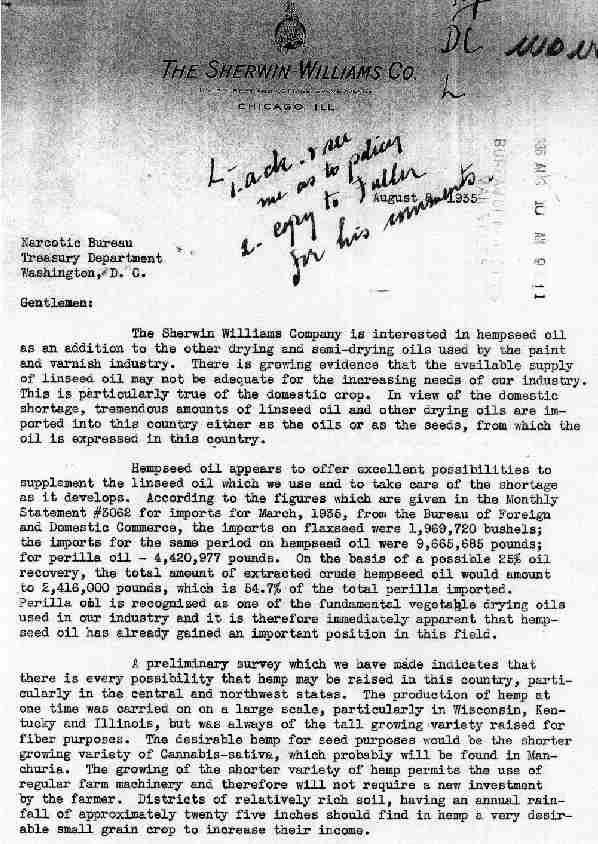
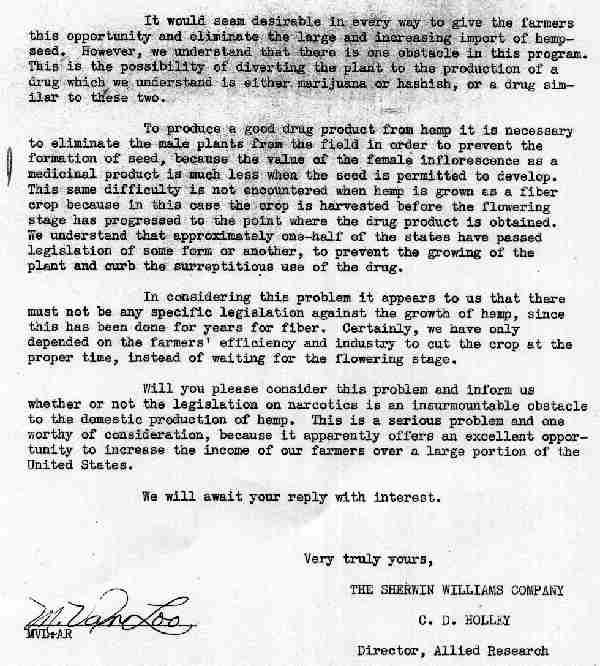
THE SHERWIN-WILLIAMS CO.
115th Street and Cottage Grove Avenue
CHICAGO, ILL.
Aug. 8, 1935
Narcotic Bureau
Treasury Department
Washington, D.C.
Gentlemen:
The Sherwin Williams Company is interested in hempseed oil as an addition to the other drying and semi-drying oils used by the paint and varnish industry. There is growing evidence that the available supply of linseed oil may not be adequate for the increasing needs of our industry. This is particularly true of the domestic crop. In view of the domestic shortage, tremendous amounts of linseed oil and other drying oils are imported into this country either as the oils or as the seeds, from which the oil is expressed in this country.
Hempseed oil appears to offer excellent possibilities to supplement the linseed oil which we use and to take care of the shortage as it develops. According to the figures which are given in the Monthly Statement #30632 for imports for March, 1935 from the Bureau of Foreign and Domestic Commerce, the imports of flaxseed were 1,969,720 bushels; the imports for the same period on hempseed oil were 9,665,685 pounds; for perilla oil - 4,420,977 pounds. On the basis of a possible 25% oil recovery, the total amount of extracted crude hempseed oil would amount to 2,416,000 pounds, which is 54.7% of the total perilla imported. Perilla oil is recognized as one of the fundamental vegetable drying oils used in our industry and it is therefore immediately apparent that hempseed oil has already gained an important position in this field.
A preliminary survey which we have made indicates that there is every possibility that hemp may be raised in this country, particularly in the central and northwest states. The production of hemp at one time was carried on on(sic) a large scale, particularly in Wisconsin, Kentucky and Illinois, but was always of the tall growing variety raised for fiber purposes. The desirable hemp for seed purposes would be the shorter growing variety of Cannabis-sativa, which probably will be found in Manchuria. The growing of the shorter variety of hemp permits the use of regular farm machinery and therefore will not require a new investment by the farmer. Districts of relatively rich soil, having an annual rainfall of approximately twenty five inches should find in hemp a very desirable small grain crop to increase their income.
It would seem desirable in every way to give the farmers this opportunity and eliminate the large and increasing import of hempseed. However, we understand that there is one obstacle in this program. This is the possibility of diverting the plant to the production of a drug which we understand is either marijuana or hashish, or a drug similar to these two.
To produce a good drug product from hemp it is necessary to eliminate the male plants from the field in order to prevent the formation of seed, because the value of the female inflorescence as a medicinal product is much less when the seed is permitted to develop. This same difficulty is not encountered when hemp is grown as a fiber crop because in this case the crop is harvested before the flowering stage has progressed to the point where the drug product is obtained. We understand that approximately one-half of the states have passed legislation of some form or another, to prevent the growing of the plant and curb the surreptitious use of the drug.
In considering this problem it appears to us that there must not be any specific legislation against the growth of hemp, since this has been done for fiber. Certainly, we have only depended on the farmers' efficiency and industry to cut the crop at the proper time, instead of waiting for the flowering state.
Will you please consider this problem and inform us whether or not the legislation on narcotics is an insurmountable obstacle to the domestic production of hemp. This is a serious problem and one worthy of consideration, because it apparently offers an excellent opportunity to increase the income of our farmers over a large portion of the United States.
We await your reply with interest.
Very truly yours,
THE SHERWIN WILLIAMS COMPANY
(signed) C.D. HOLLEY
Director. Allied Research
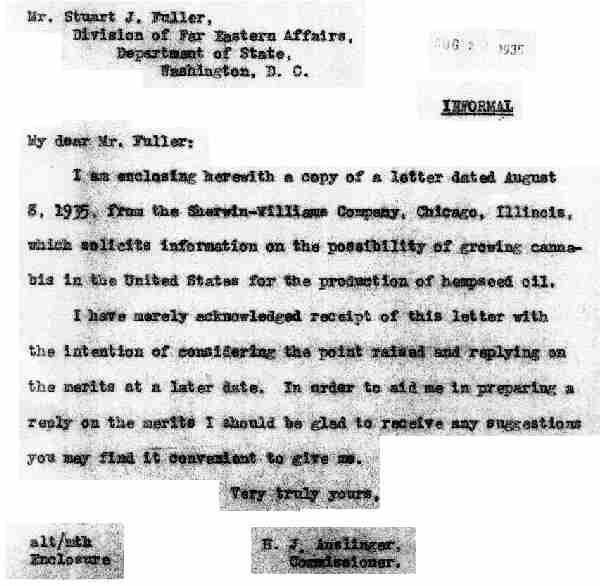
Mr. Stuart J. Fuller,
Division of Far Eastern Affairs,
Department of State,
Washington, D.C.
INFORMAL
My Dear Mr. Fuller:
I am enclosing herewith a copy of a letter dated August 8, 1935 from the Sherwin-Williams Company, Chicago, Illinois, which solicits information on the possibility of growing cannabis in the United States for the production of hempseed oil.
I have merely acknowledged receipt of this letter with the intention of considering the point raised and replying on the merits at a later date. In order to aid me in preparing a reply on the merits I should be glad to receive any suggestions you may find it convenient to give me.
Very truly yours,
H.J. Anslinger,
Commissioner,
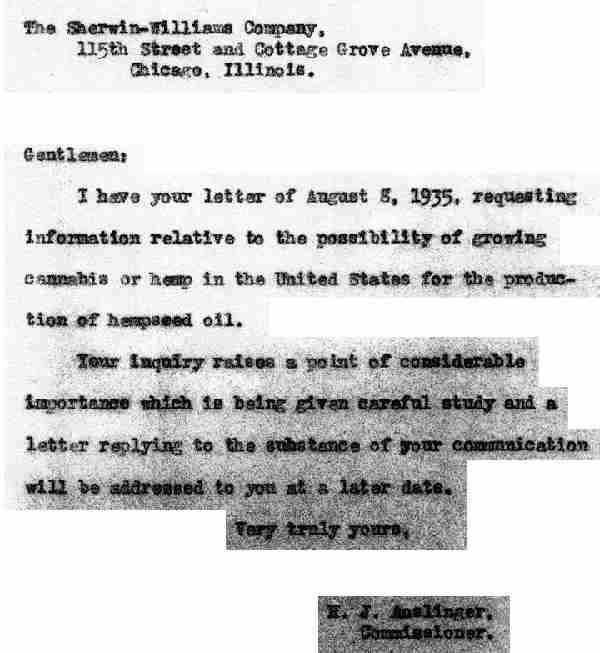
The Sherwin-Williams Company
115th Street and Cottage Grove Avenue
Chicago, Illinois
Gentlemen:
I have your letter of August 8, 1935, requesting information relative to the possibility of growing cannabis or hemp in the United States for the production of hempseed oil.
Your inquiry raises a point of considerable importance which is being given careful study and a letter replying to the substance of your communication will be addressed to you at a later date.
Very truly yours,
J.H. Anslinger
Commissioner.
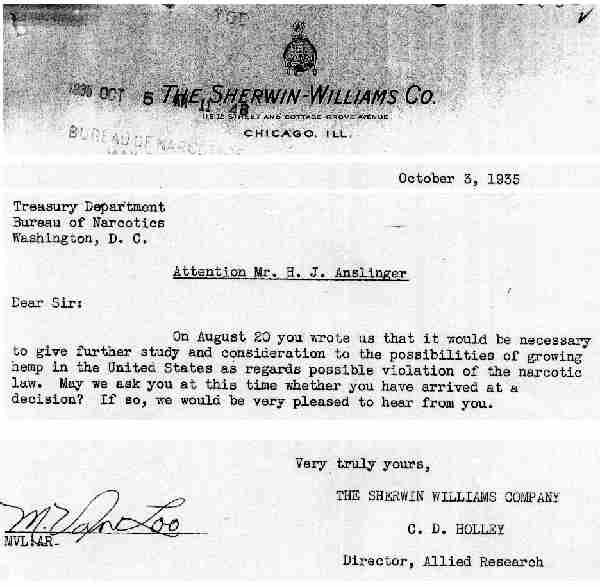
THE SHERWIN-WILLIAMS CO.
115th Street and Cottage Grove Avenue
CHICAGO, ILL.
Oct. 3, 1935
Treasury Department
Bureau of Narcotics
Washington, D.C.
Attention Mr. H.J. Anslinger
Dear Sir:
On August 20 you wrote us that it would be necessary to give further study and consideration to the possibilities of growing hemp in the United States as regards possible violation of the narcotic law. May we ask you at this time whether you have arrived at a decision? If so, we would be very pleased to hear from you.
Very truly yours,
THE SHERWIN WILLIAMS COMPANY
(signed) - C.D. HOLLEY
Director, Allied Research
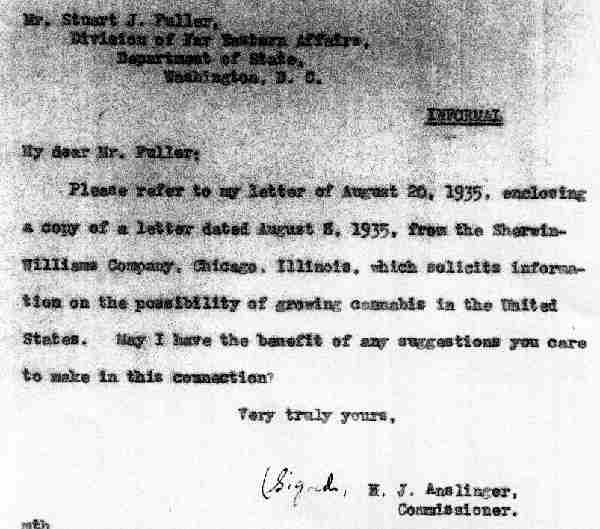
Mr. Stuart J. Fuller,
Division of Far Eastern Affairs,
Department of State,
Washington, D.C.
INFORMAL
My Dear Mr. Fuller:
Please refer to my letter of August 20, 1935, enclosing a copy of a letter dated August 8, 1935, from the Sherwin-Williams company, Chicago, Illinois, which solicits information on the possibility of growing cannabis in the United States. May I have the benefit of any suggestions you care to make in this connection?
Very truly yours,
H.J. Anslinger
Commissioner
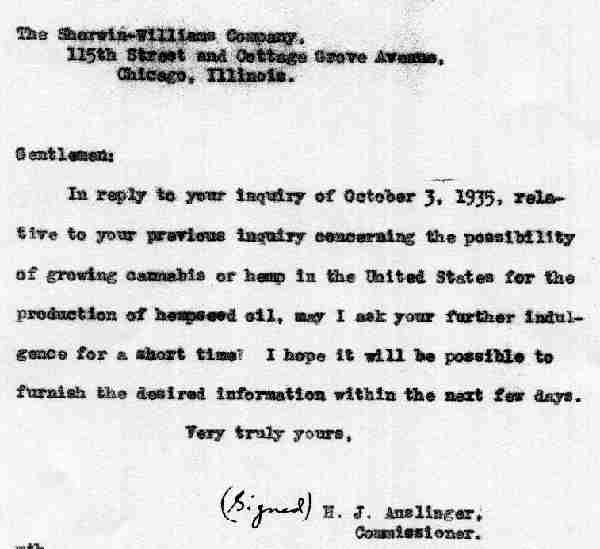
THE SHERWIN-WILLIAMS CO.
115th Street and Cottage Grove Avenue
CHICAGO, ILL.
Gentlemen:
In reply to your inquiry of October 3, 1935, relative to your previous inquiry concerning the possibility of growing cannabis or hemp in the United States for the production of hempseed oil, may I ask your further indulgence for a short time? I hope it will be possible to furnish the desired information within the next few days.
Very truly yours
H.J. Anslinger
Commissioner
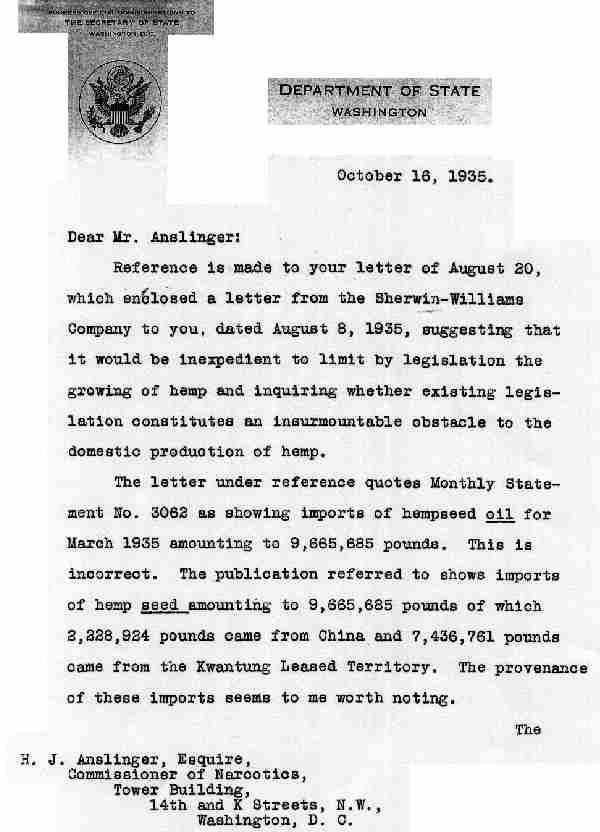
Department of state
Washington
Oct. 16, 1935
Dear Mr. Ansligner:
Reference is made to your letter of August 20, which enclosed a letter from the Sherwin-Williams company to you, dated August 8, 1935, suggesting that it would be inexpedient to limit by legislation the growing of hemp and inquiring whether existing legislation constitutes an insurmountable obstacle to the domestic production of hemp.
The letter under reference quotes Monthly Statement No. 3062 as showing imports of hempseed oil for March 1935 amounted to 9,665,685 pounds. This is incorrect. The publication referred to shows imports of hemp seed amounted to 9,665,3685 pounds of which 2,228,924 pounds come from China and 7,436,761 pounds came from the Kwantung Leased Territory. The province of these imports seems to me worth nothing.
The Department of Commerce has supplied additional figures concerning the import of hemp seed and of hempseed oil which are enclosed herewith. These indicate that the seed imports have increased from a value of $67,886.oo in 1930 to $677,035.oo for the first six months of 1935, while the oil imports are valued at only a few thousand dollars. We have thus been importing increasing quantities of seed to be pressed into oil in the United States. Our paint and varnish manufacturers thus seem to have had their needs for hempseed oil hither-to supplied without any attendant risk from large quantities of cannabis resin available for abuse.
The Sherwin-Williams Company appears to suggest the introduction into the United States of a new venture in agriculture, the growing of a low type of cannabis unsuited for fiber purposes, the object being to provide paint and varnish manufacturers with a domestic source of supply of hempseed oil in lieu of importing the seed as at present. This raises the question whether the possible advantage to be gained thereby is sufficient to counterbalance the very obvious danger of increasing the extensive supply of cannabis sativa already available for illicit traffic and for the satisfaction of addiction.
It would seem to me, on first examination, that it is much better to let " the other fellow " grow the seed while we press the oil in this country, thus keeping the resin out.
The Sherwin-Williams Company's contention that the cultivation of hemp for the seed only would be a profitable venture for farmers, while it may be correct, should not, in my opinion, be accepted without investigation. I am no farmer, but it would seem to me that growing of flax would be even more profitable and just as easy and would, furthermore, avoid the danger inherent in large growing fields of cannabis which seeds itself wild and which affords a supply of the dangerous resin. Also, I gravely doubt whether the American farmer could compete successfully with the Manchurian coolie in producing hemp seed.
It is my understanding that the oils principally used in the manufacture of paints and varnishes are linseed oil, tung oil (also known as "wood oil") perilla oil and hempseed oil. I believe that tung, perilla and hempseed oils are all quicker drying than is linseed oil. Understanding that there is available a plentiful supply of linseed oil, tung oil, hempseed oil and perilla oil, I infer that the Sherwin-Williams Company's main object is not so much to supply a lack of raw material as, possible, to obtain a cheaper vegetable drying oil. Whether growing cannabis in the United States would accomplish that end seems to me open to question.
I know of no Federal legislation which would apply to the growing of hemp. It would appear to me that, under the Uniform State Narcotic Law, it would be possible to grow hemp, provided the farmer were to take out a license under Section 3 of that law. There is thus no "insurmountable obstacle" to the domestic production of hemp for legitimate purposes.
Other features of the situation which, to my mind, would bear looking into are: (1) the extent to which the resin my be expected to have formed by the time when the seed is harvested; (2) how that resin would be separated from the seed; and (3) what disposition would be made of such resin.
Yours sincerely,
(signed) Stuart J. Filler
Assistant Chief
Division of Far Eastern Affairs
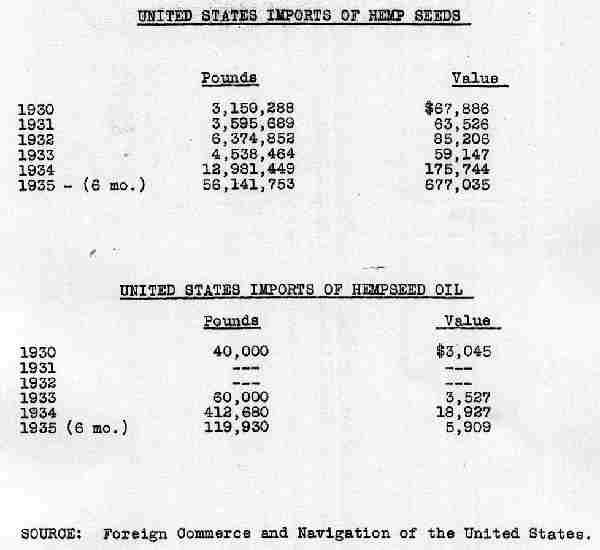
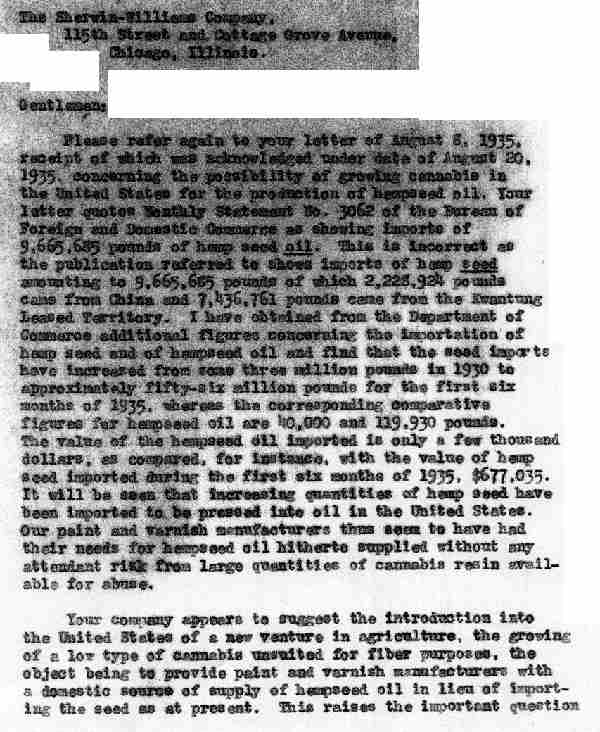

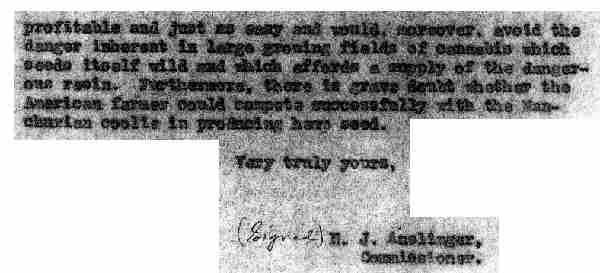
THE SHERWIN-WILLIAMS CO.
115th Street and Cottage Grove Avenue
CHICAGO, ILL.
Gentlemen:
Please refer again to your letter of August 20, 1935, receipt of which was acknowledged under date of August 20, 1935, concerning the possibility of growing cannabis in the UNITED States for the production of hempseed oil. Your letter quotes Monthly Statement No. 3062 of the Bureau of foreign and Domestic commerce as showing imports of 9,665,685 pounds of hemp seed oil. This is incorrect as the publication referred to shows imports of hemp seed amounting to 9,665,685 pounds of which 2,228,924 pounds came from China and 7,436,761 pounds came from the Kwantung East Territory. I have obtained from the Department of commerce additional figures concerning the importation of hemp seed and of hempseed oil and find that the seed imports have increased from some three million pounds in 1930 to approximately fifty-six million pounds for the first six months of 1935, whereas the corresponding comparative figures for hempseed oil are 40,000 and 119,930 pounds. The value of the hempseed oil imported is only a few thousand dollars, as compared, for instance, with the value of hemp seed imported during the first six months of 1935, $677,035. It will be seen that increasing quantities of hemp seed have been imported to be pressed into oil in the United States. Our paint and varnish manufacturers thus seem to have had their needs for hempseed oil hitherto supplied without any attendant risk from large quantities of cannabis resin available for abuse.
Your company appears to suggest the introduction into the United States of a new Venture in agriculture, the growing of a low type of cannabis unsuited for fiber purposes, the object being to provide paint and varnish manufacturers with a domestic source of supply of hempseed oil in lieu of importing the seed as at present. This raises the important question whether the possible advantage to be gained thereby is sufficient to counterbalance the very obvious danger of increasing the extensive supply of cannabis sativa already available for illicit traffic and consumption by way of abuse. There is no doubt that there is in the aggregate an extensive growth of cannabis throughout the United States. In one or two states it is openly cultivated for fiber and to some extent, for the seed as bird food. In many other localities it has been discovered to be clandestinely cultivated for harvesting the flowering tops which are made into cigarettes and sold more or less surreptitiously, and the effect on the smoker of such cigarettes is notoriously deleterious. There is, of course, some medical use for the cannabis which is extracted from the resin of the flowering tops, but while statistics are not available of the total growth of the hemp in the country, there can hardly be any doubt that the most of the flowering tops harvested from all the hemp grown is eventually applied to an abusive use. There is increasing evidence that the cigarettes are being distributed among and even by adolescents, and the grave problem is thus presented as to what steps should be taken to curb this means of corruption of the younger generation.
There is no Federal narcotic law dealing with the growth, sale and distribution of cannabis. Some 36 states have laws regulating the sale or possession of the drug and restricting its distribution except for medical purposes. 16 of these states either prohibit or regulate the cultivation and growth of cannabis. Public opinion generally is being aroused by the steady accumulation of reports showing the evils attendant upon the abuse of the drug and by atrocities committed by persons under its influence, and the Bureau looks forward to an increasing degree of state control over the growth and distribution of cannabis, not only by providing appropriate legislation where necessary, but by more drastic enforcement of existing legislation on the subject. In view of these circumstances it appears to this Bureau that every effort should be made to restrict rather than to extend this growth of cannabis in the United States, and to continue importing the seed for expressing the oil in this country, eliminating the danger inherent in the accumulation of the resin which is available if the hemp seed are domestically grown. While the Bureau is not equipped to express an opinion upon the phase of the matter dealing with agriculture, it does venture to state that the growing of flax might be even more profitable and just as easy and would, moreover, avoid the danger inherent in large growing field of cannabis which seeds itself wild and which affords a supply of the dangerous resin. Furthermore, there is grave doubt whether the American farmer could compete successfully with the Manchurian coolie in producing hemp seed. Very truly yours,
H.J. Anslinger
Commissioner
WANT TO KNOW MORE:
=====================
Due to space / download time considerations, only selected materials are displayed. If you would like to obtain more information, feel free to contact the museum. All our material is available (at cost) on CD-Rom format.
CONTACT PAGE
 ILLINOIS BACK TO MAIN PAGE |